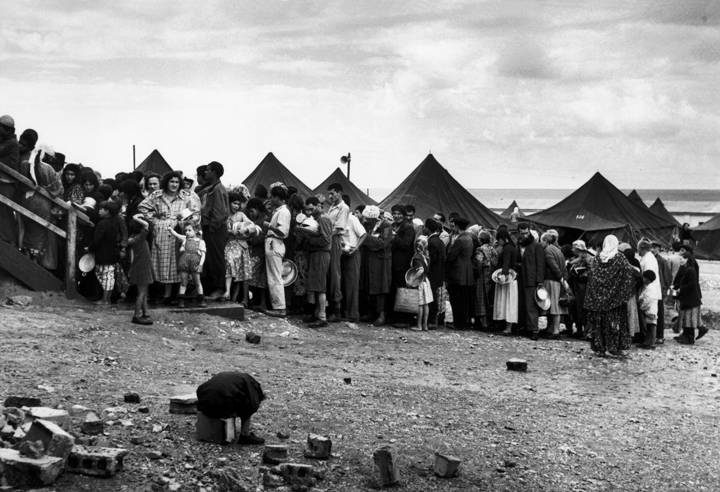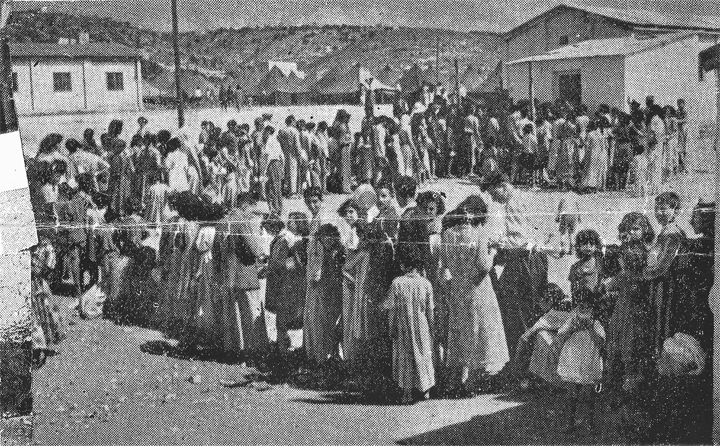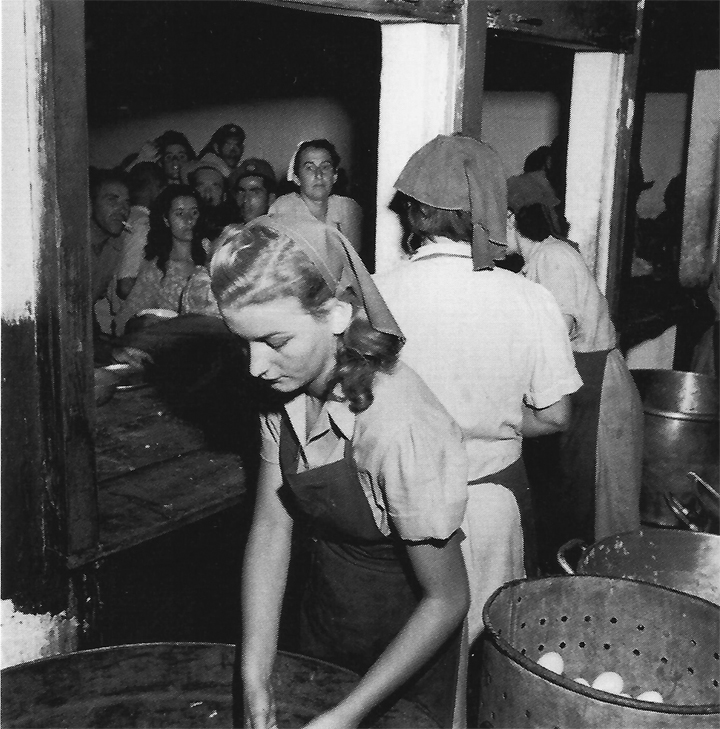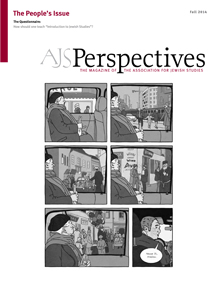
Center of Photography. Courtesy of Magnum Photos

***
In March 1950, one year after the Jewish Agency had opened Sha'ar Ha-'aliyah ("The Gate of Aliyah"), an Ellis Island-like camp near Haifa, the newspaper Ha-dor reported on a violent encounter that took place in one of the camp's many lines:
I was an eyewitness to the shameful display whereby an employee, by the name of Reis, grabbed a French-speaking immigrant by the throat and went to throw him outside . . . Bloodshed was prevented through the intervention of other employees (S. Harzion, Ha-dor, March 25, 1950).
Very quickly, Harzion's piece got the attention of Sha'ar Ha-'aliyah's director, Yehudah Weisberger, who promptly contacted Shim'on Reis (the employee mentioned in the article) and asked for an immediate explanation. By the next day Reis had submitted to Weisberger his own account of the incident:
On the day indicated in Ha-dor I was sitting, as usual, in my seat, receiving the public. Suddenly, from behind the door, I heard screams—as well as a dramatic cry of "Reis!" [. . .] Inside, the official was struggling with a tall and strong young man (apparently from Morocco) who did not want to stand in line and had broken in by force. I wanted to rescue the official as well as restore order, and I tried to explain to the young man (without the use of physical force) that he, first of all, had to stand in line, like everyone else and, second of all, he had to obey the official. But the young man did not want to listen to me, jumped upon me and took a swing at me—which I managed to avoid (CZA AK 456/3).
Weisberger was satisfied with this explanation. When he reported back to the Sha'ar Ha-'aliyah police on what had happened, he relied on Reis's own statement before adding his own analysis:
Knowing the situation in the camp, it's unthinkable that someone working in the reception would treat a new immigrant in the way Mr. Harzion described, and we are inclined to the opinion that these details found their way into the [published] letter from Mr. Harzion's imagination: It is hard to believe that Mr. Reis was the attacker in the mentioned incident, and it is most likely that the description given by Reis himself is closer to the truth (CZA AK 456/3).
What made Weisberger come to Reis's defense so unequivocally? Was it purely out of loyalty to his employees? Was it because of his own prejudices against the immigrant Reis described as "apparently from Morocco"? Certainly "knowing the situation in the camp," as Weisberger did, it is not hard to imagine that any immigrant confronting Sha'ar Ha-'aliyah's lines could have snapped. The camp itself was built to hold five thousand immigrants, who were meant to stay there for only around four to five days to undergo a medical exam and then be assigned their permanent places of residence in Israel before being bussed to their new homes throughout the country. But what actually happened was that it became impossible to evacuate the immigrants already residing there before new ships and planes arrived. Although some people did manage to complete their processing and leave in a number of days, many others ended up staying in Sha'ar Ha-'aliyah for weeks or months. The camp was filled beyond capacity with thousands more people than it was intended to hold, the premises were filthy, conditions were tense and often spiraled out of control.
The grueling line became a symbol of Sha'ar Ha-'aliyah and the challenges and disappointments of immigration. One photograph of the camp shows at least fifty-eight people in line and another has over one hundred—and these are only the people visible to the camera. Immigrants who had just arrived to Israel after drawn-out, often extremely difficult journeys (in the broadest sense), had to wait in these impossibly long, unruly lines before their every meal, before their medical examination, and then before their encounter with the final processing committee. The lines were the result of overcrowding, misunderstandings, and eagerness to leave Sha'ar Ha-'aliyah as soon as possible. Because of language barriers, people did not always understand where they were supposed to be and when. Sometimes people would arrive at their appointments early—they were eager to finish the processing as quickly as possible—and they would end up waiting for hours. It was then, after waiting so long, that the new immigrant—often exhausted and frustrated— interacted with the Sha'ar Ha-'aliyah staff: men and women like Shim'on Reis.
Yet, it's just as easy to imagine that a person working in the camp could have snapped, since receiving the lines wasn't necessarily much easier than standing in them. Many of the people who worked in Sha'ar Ha-'aliyah were themselves immigrants, with varying degrees of newness. Their jobs gave them the security of a paying job with vacation time and opportunities for promotion in a difficult economy, but it was hard to deal with the crowds, the dirt, and the unattainable expectations (of the immigrants as well as the often idealistic clerks) day after day. In many cases there wasn't a common language between the immigrants and the camp personnel, and often there seemed to be no way to bridge the huge cultural gaps that separated people. Shim'on Reis claims to have "tried to explain to the young man" that he had to stand in line. Perhaps he did. But he gives us no reason to believe that they actually understood one another.

As it turns out, over a year later Shim'on Reis was sentenced to a month in prison after he attacked a different immigrant—a man from Iraq who had himself been arrested by the Sha'ar Ha-'aliyah police. The following post appeared in Haaretz in August, 1951:
According to Reis, he lost his temper when he saw the police's tepid response to the arrested men, who had been accused of attacking police officers and Jewish Agency officials . . . after witnessing the leniency of the police he decided to punish one of the "criminals" himself.
This later guilt does not necessarily mean that Reis also attacked the immigrant in 1950 (although it certainly casts a shadow on his character). Based on the existing evidence we still aren't left with a definite culprit. Instead, what we are left with is a glimpse into why these grueling lines became a symbol of people's experiences in Sha'ar Ha-'aliyah; a sense of how either man may have been pushed to a breaking point; as well as, perhaps, a sense of amazement that—in such an environment—these stories were the exceptions and not the rule.
Sha'ar Ha-'aliyah was the first stop on Israeli soil for nearly 400,000 Jewish "diasporic" immigrants; a place where they began to be transformed into the Israeli people and the Israeli people began to be (profoundly) transformed by them. The Jewish Agency conceived of it as an isolated space where the masses could be met, contained, and controlled with order. But, in so many ways, the immigrants who went through Sha'ar Ha-'aliyah defied this balance of power. The people who emerged from this flawed process were emboldened, often disappointed, vocally and physically defiant, and carried with them a strong sense of entitlement to the goings-on in their state. In the controlled chaos of the Sha'ar Ha-'aliyah lines we can see the people, and the newly complicated encounters between people, that were bringing Israel to life.


 Rhona Seidelman, a visiting assistant professor in the Program in Jewish Culture and Society (the University of Illinois at Urbana-Champaign) received her PhD in History from Ben-Gurion University of the Negev. Her most recent articles have been published in The American Journal of Public Health, The Journal of Israeli History, and Ha’aretz. Her book manuscript is tentatively titled Under Quarantine at Israel’s Ellis Island (Shaar Ha’aliya) 1949-1952.
Rhona Seidelman, a visiting assistant professor in the Program in Jewish Culture and Society (the University of Illinois at Urbana-Champaign) received her PhD in History from Ben-Gurion University of the Negev. Her most recent articles have been published in The American Journal of Public Health, The Journal of Israeli History, and Ha’aretz. Her book manuscript is tentatively titled Under Quarantine at Israel’s Ellis Island (Shaar Ha’aliya) 1949-1952.